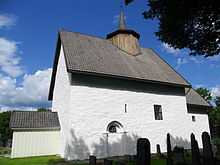Bø, Telemark
| Bø kommune | |||
|---|---|---|---|
| Municipality | |||
| |||
 Bø within Telemark | |||
| Coordinates: 59°27′26″N 9°1′53″E / 59.45722°N 9.03139°ECoordinates: 59°27′26″N 9°1′53″E / 59.45722°N 9.03139°E | |||
| Country | Norway | ||
| County | Telemark | ||
| District | Midt-Telemark | ||
| Administrative centre | Bø i Telemark | ||
| Government | |||
| • Mayor (2003) | Arne Storhaug (Ap) | ||
| Area | |||
| • Total | 263 km2 (102 sq mi) | ||
| • Land | 258 km2 (100 sq mi) | ||
| Area rank | 292 in Norway | ||
| Population (1.1.2010) | |||
| • Total | 5,595 | ||
| • Rank | 188 in Norway | ||
| • Density | 20/km2 (50/sq mi) | ||
| • Change (10 years) | 8.5 % | ||
| Demonym | Bøhering[1] | ||
| Time zone | CET (UTC+1) | ||
| • Summer (DST) | CEST (UTC+2) | ||
| ISO 3166 code | NO-0821 | ||
| Official language form | Nynorsk | ||
| Website |
www | ||
|
| |||
Bø is a municipality in Telemark county, Norway. It is part of the traditional region of Midt-Telemark. The administrative centre of the municipality is the village of Bø i Telemark ("Bø in Telemark"). Bø has been a parish since ancient times and became a municipality (formannskapsdistrikt) in 1838. The area of Lunde was separated from Bø in 1867 to become a separate municipality.
Bø's economy is mainly based on agriculture, forestry, tourism, education and public administration, and Bø is home to the main campus of Telemark University College. Bø is well known for its cultural traditions within traditional music and artisanship, and its central position within Norwegian national romanticism with e.g. its Bunad traditions. Bø has several times been called "the most beautiful place on earth" in modern literature, e.g. in Bjørnstjerne Bjørnson's story, En glad Gut ("A Happy Boy").
General information

Name
The municipality (originally the parish) is named after the old Bø farm (Old Norse: Bœr), since the first church was built here. The name is identical with the word bœr which means "homestead" or "farm".[2]






Coat-of-arms
The coat-of-arms is from modern times. They were adopted on 19 February 1988. The arms show three gold-colored fiddles on a red background. Bø is historically known for its musical tradition, as well as the production of fiddles (similar to the hardingfele). The fiddle was thus chosen as an appropriate symbol for the municipality.[3][4]
Education
In 1923 the county of Telemark decided to start a secondary school in Bø, the equivalent of today's middle school or "ungdomsskole", called Telemark Realskole. At this time secondary schools mostly existed in the larger towns and cities, and most youngsters ended their schooling after 7 years. It was the county's intention to expand this school to a high school as soon as practically possible. This happened in 1947, and the school's name was Telemark Offentlige Landsgymnas. The existence of this school made it possible to establish Telemark College (Distriktshøgskulen i Telemark), which evolved into Telemark University College.
Attractions
Bø is famous for its waterpark Sommarland (the largest of its kind in Norway). Another popular sight in Bø is the Gygrestol rock formation. There is also Kroa i Bø, one of the oldest and most respected music scenes in Norway. The club won the award for "Concert promoter of the Year 2005" and is based on voluntary work from students of the Telemark University College.
Notable residents
- Halvor Kleppen, TV presenter
- Neri Valen, Member of Parliament
- Hallvard Eika, Member of Parliament
- Olaf Rye, General
- Geir Barvik, banker
- Lars Arvid Nilsen, shot putter
- Agnes Buen Garnås, traditional musician
- Øyvind Storesund, musician
Sister cities
The following cities are twinned with Bø:[5]
-
 Bengtsfors, Västra Götaland County, Sweden
Bengtsfors, Västra Götaland County, Sweden -
 Puumala, Eastern Finland, Finland
Puumala, Eastern Finland, Finland
References
- ↑ "Personnemningar til stadnamn i Noreg" (in Norwegian). Språkrådet.
- ↑ Rygh, Oluf (1914). Norske gaardnavne: Bratsbergs amt (Dokumentasjonsprosjektet) (in Norwegian) (7 ed.). Kristiania, Norge: W. C. Fabritius & sønners bogtrikkeri. p. 197.
- ↑ Norske Kommunevåpen (1990). "Nye kommunevåbener i Norden". Retrieved 2009-01-17.
- ↑ "Kommunevåpen og ordførarkjede" (in Norwegian). Bø kommune. Retrieved 2009-01-17.
- ↑ "Vennskapskommunar" (in Norwegian). Bø kommune. Retrieved 2009-01-17.
External links
 Media related to Bø at Wikimedia Commons
Media related to Bø at Wikimedia Commons The dictionary definition of Bø at Wiktionary
The dictionary definition of Bø at Wiktionary- Municipal fact sheet from Statistics Norway
 Telemark travel guide from Wikivoyage
Telemark travel guide from Wikivoyage- Bø Sommarland waterpark (Norwegian)
- Kroa i Bø music venue

